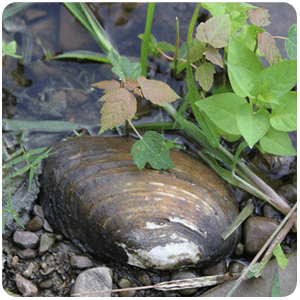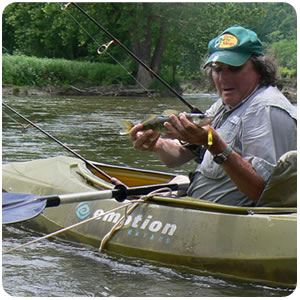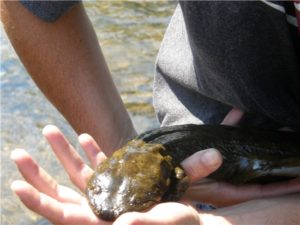Introduction
More types of fish and mollusks are found in French Creek than any other stream in Pennsylvania. The Watershed is home to 27 species of mussels, 15 species of darters, and has four nationally designated Important Bird Areas (IBA). Many species that thrive in French Creek have been extirpated from their natural ranges due to habitat loss and degradation of water quality. Nevertheless, French Creek remains relatively healthy, leading The Nature Conservancy to include the French Creek Watershed in its listing of national “hot spots” with ten or more at-risk fish and mussel species, and citing it as a critical watershed to conserve these species.
Freshwater Mussels 
The French Creek Watershed contains 27 of Pennsylvania’s approximately 65 species of freshwater mussels, the most diverse population of any stream in the state, and any stream further north and east in the nation. Four of these, the Northern Riffleshell (Epioblasma torulosa rangiana), Rayed Bean (Villosa fabalis), Snuffbox (Epioblasma triquerta) and Clubshell (Pleurobema clava), are classified as federally endangered in North America. Mussels require clean, oxygen-rich water to filter food and absorb dissolved oxygen. In the microscopic larval stage called glochidia, mussels often attach to the gills and fins of fish such as darters and are transported to different sites on the stream. As a result, their distribution and numbers are directly linked to the survival of these host fish.
Darters & Game Fish
 More than 80 species of fish are found in the stream, including 15 species of darters—small, colorful perch-like fish that feed on small crustaceans, larvae and flies around and under rocks. Two species are endangered in the watershed: the Iowa Darter (Etheostoma exile) and the Eastern Sand Darter (Etheostoma pellucidum) and four others are listed as threatened in Pennsylvania. Spotted Darters (Etheostoma maculatum) exist only in the French Creek and the Upper Allegheny River. Darters depend on clean, unpolluted water. Major threats to the fish are habitat alteration or loss, pollution, and competition from exotic species such as the round goby.
More than 80 species of fish are found in the stream, including 15 species of darters—small, colorful perch-like fish that feed on small crustaceans, larvae and flies around and under rocks. Two species are endangered in the watershed: the Iowa Darter (Etheostoma exile) and the Eastern Sand Darter (Etheostoma pellucidum) and four others are listed as threatened in Pennsylvania. Spotted Darters (Etheostoma maculatum) exist only in the French Creek and the Upper Allegheny River. Darters depend on clean, unpolluted water. Major threats to the fish are habitat alteration or loss, pollution, and competition from exotic species such as the round goby.
French Creek also supports healthy populations of smallmouth bass, walleye, panfish, northern pike and muskellunge, species prized by sport anglers, and most of its tributaries are annually stocked with trout. The West Branch also supports the PA threatened mountain brook lamprey (Ichthyomyzon greeleyi) and Ohio lamprey (Ichthyomyzon bdellium).
Birds & Waterfowl 
Many of the 379 bird species that nest, winter or migrate throughout Pennsylvania can be found in the French Creek Watershed. The region is located near the convergence of major migratory routes for songbirds and waterfowl traveling to the Atlantic Coast, Mississippi River and Gulf of Mexico from areas in the northeastern U.S. and Canada. Thanks to its diversity of habitats, bird-sighting opportunities exist year round at French Creek. In addition to songbirds and waterfowl, numerous raptors are found in the watershed, including osprey and bald eagles. Eagles were once reduced in Pennsylvania to only three mating pairs in 1980. Today there are hundreds of successful mating pairs across the state with Crawford County having the most nests within the watershed.
Unique Plant Communities
 The French Creek Watershed is located within the Northern Hardwood Forest community characterized by dominant species that includes sugar maple (Acer saccharum), American beech (Fagus grandifolia), and eastern hemlock (Tsuga canadensis) interspersed with white pine (Pinus strobus) and oaks (Quercus spp.). Lakes and marshes created during glaciation, along with intensive timbering and agricultural clearing in the 19th and 20th centuries, have created farmland, grassland, old-field and wetland habitats supporting an array of diverse plant communities.
The French Creek Watershed is located within the Northern Hardwood Forest community characterized by dominant species that includes sugar maple (Acer saccharum), American beech (Fagus grandifolia), and eastern hemlock (Tsuga canadensis) interspersed with white pine (Pinus strobus) and oaks (Quercus spp.). Lakes and marshes created during glaciation, along with intensive timbering and agricultural clearing in the 19th and 20th centuries, have created farmland, grassland, old-field and wetland habitats supporting an array of diverse plant communities.
Numerous rare and endangered plant species are found in the watershed, including the showy lady’s slipper (Cypripedium reginae), a threatened species in Pennsylvania. Wetlands surrounding Lake Pleasant, located near the town of Waterford, provide habitat for more than twenty plant species of special concern in the state, including northern water milfoil (Myriophyllum sibiricum), rush aster (Aster borealis) and cuckoo-flower (Cardamine pratensis). Lake Pleasant also has two fish species, the blackchin shiner (Notropis heterodon) and Iowa darter (Etheostoma exile) that are endangered in the state. The largest bottomland forest in the Pennsylvania headwaters is found in the South Branch sub-basin, also a home to rare plant species in its fens and seeps.
Signature Salamander 
Eastern hellbenders (Cryptobranchus alleganiensis)–giant aquatic salamanders that can reach 30 inches in length and weigh over five pounds—are one of the most unique creatures in the French Creek Watershed. Hellbenders require cool, clear, rock-laden streams which are oxygen rich for its habitat where it preys on crawfish, fish, insects, and worms. Although it has lungs, a hellbender breathes by absorbing oxygen from the water through thousands of capillaries located in the wrinkled folds of the skin on its sides. Known as old lasagna sides, devil dog, mud devil or snot otter, this nocturnal aquatic salamander with its flat head and body, short stubby legs, rudder tail and its distinctive wrinkled skin are very identifiable. French Creek supports a stable population of eastern hellbenders; however, their numbers have been reduced in many eastern streams due to acid mine drainage, siltation, and industrial pollution. While hellbenders are not protected under the federal Endangered Species Act, some states give them protected status. In Pennsylvania they are a “species of special concern”.
Is a hellbender the same thing as a mudpuppy?
No–they are two different species! French Creek’s signature salamander, the Eastern Hellbender–Cryptobranchus alleganiensis, is Pennsylvania’s largest salamander and can grow up to 30 inches long and weigh as much as five pounds. They also have very identifiable wrinkly skin on their sides that resemble a lasagna noodle. A Mudpuppy–Necturus maculosus, is a different species than the hellbender. It is Pennsylvania’s second largest salamander and is smaller in size. A Mudpuppy has a triangular shaped head and is easily distinguished by its visible collar of reddish orange external gills.


